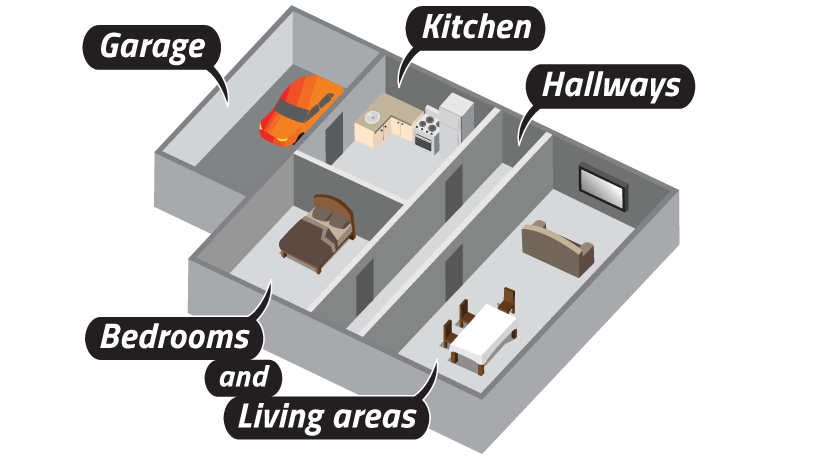Home Safety System
Fire safety is extremely important in every corner of your home. Each area has unique circumstances with certain risks, and whilst smoke detectors are vital throughout your house, we have models that are better in some rooms compared to others.
The Family First Home Safety System makes it easy for you to choose which fire safety products are suitable or recommended in certain locations around your house. Choose an area to see what we recommend.
Have a home fire escape plan
A fire escape plan is an essential safety measure that gives clear instructions to householders about how best to escape from a fire. It should be rehearsed at least 3-4 times per year. It’s always best to aim for less than a 2 minute escape.
Alternating the time of day the rehearsal occurs will prepare you and your family for different conditions. A good fire escape plan includes two of the quickest escape paths from each area of the home.
All escape paths need to be checked regularly to make sure they are always accessible and ready for use.
The safest way to escape a house fire is to crawl out. Poisonous gases and heavy smoke created from burning materials rise to the ceiling. Crawling allows you to get under the polluted air to more easily exit your home.

- If windows have been chosen as an escape path install a fire escape ladder should it be required. If a window needs to be smashed to escape, place a thick material to cover any broken glass on the frame and floor to avoid cuts. In the event of a fire, locating these types of materials is a stressful experience. We recommended having these types of thick materials near window so in the event of a fire you’re ready to escape.
- For older adults and people with access or functional needs locate their sleeping area near an exit that is located on the ground floor for a quick escape. Check that any assisting equipment (e.g. wheelchairs) can easily pass through walkways and doors.
- To check if a room is safe to enter feel the doorknob with the back of your hand. If it feels hot then leave it closed. Open any door slowly as smoke and poisonous gases can enter from the other room or corridor. If this occurs shut the door quickly.
- If clothes ignite from flames or heat stop immediately, drop to the ground and cover your face with your hands. Roll from side to side until the fire is out. A quick way to extinguish burning clothes is using a woollen blanket or fire blanket.
- Remember to close all doors behind you and never re-enter the home for any reason. Never risk your own personal safety to retrieve belongings.
- If you are unable to escape a fire from any room make sure the door is closed, seal any cracks or vents to avoid any smoke entering the room and contact the fire brigade.
- If it is difficult to rescue someone or a pet in the event of the fire leave the home and contact the fire brigade.
- Look around your home for any potential fire risks such as frayed electrical cabling, overloaded power boards and malfunctioning equipment.
- Never recharge electrical equipment on soft furnishings such as a bed linen. In the kitchen, never leave cooking unattended. The garden has many natural fuel sources to start and grow a fire, a well maintained and clean garden reduces the risk of these fuels igniting. Investing in fire mitigation equipment such as fire extinguishers and fire blankets can help stop a fire before it becomes out control.
- As an additional level of protection if you have any fuel burning appliances such as gas heating have them tested by a qualified service technician for any trace of carbon monoxide which is a tasteless, odourless and colourless gas. Install a carbon monoxide alarm in every sleeping area to avoid carbon monoxide poisoning which can lead to death.
More home safety advice
Check our frequently asked questions for more help with fire protection products to keep your family and your assets safe at home.




